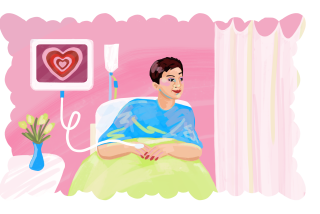In Practice: The risk of a cry unheeded
- Share via
Mike didn’t talk much. After all, I was a stranger, another one of the guardians in a white coat that kept him imprisoned in the locked ward of St. Elizabeths Hospital in Washington, D.C.
The hospital needed a medical resident to do basic physicals on its newly admitted patients. It was my turn to rotate on the service. Like most teens there, 16-year-old Mike (not his real name) had been sent to the ward after being arrested for some combination of minor vandalism, underage drinking, disturbing the peace and generally “acting out.” I was convinced that these misbehaviors were cries for help rather than actions demanding punishment. I hoped I could lend Mike a sympathetic ear along with my medical expertise.
I tried to win the young man’s trust by banishing the hovering hospital staff to posts outside the door. When we were alone, I reassured him that everything he told me would be kept confidential.
As I began taking the history, I noticed Mike had picked up the drawstring for the blinds covering the window and was twisting the cord in his hands. He seldom met my gaze, preferring to stare at his feet and mumble monosyllabic answers to my litany of questions. Uncomfortable with the tense moments of silence, I began asking longer and longer questions. Mike, looking down, followed each with a reluctant grunt or short, flat response.
After a few minutes, Mike turned his head toward the window, raised his hands and began wrapping the cord around his neck. Then he slowly unwound the drawstring, brought it down to his lap — and, after a few beats, inched it toward his neck once again.
I watched him for a few minutes before finally asking the obvious question: “Um, what are you doing with that?”
He said nothing, continuing to wrap and unwrap the cord around his neck like a shopper trying on necklaces in a jewelry store.
“Mike …?” Dreading the answer, I had a hard time forcing out the words. “You don’t want to kill yourself … do you?”
The young man kept staring at his feet, his hands fastening and unfastening an imaginary clasp in the back of his neck.
I was deeply worried and at a loss about what to do. Mike could easily hang himself with the drawstring. He needed to be moved to a safer room and kept under observation for his own protection. A word from me to the hospital staff would guarantee Mike’s safety.
But only a few minutes ago, I had promised this young man that I wouldn’t reveal his secrets.
There was one more option that might allow Mike to get the care he needed without violating my oath — or his trust. It was worth a try. I took a deep breath.
“Mike, listen to me. I don’t want you to hurt yourself. The staff here can protect you.”
“You’re going to tell them?” His tone was angry, accusing.
I shook my head. “No,” I said in a soft voice. “You are. We’ll do it together. You won’t get in trouble, I promise. You’re here to get help.”
I waited for him to speak. Slowly, he lowered his hands and let the cord drop to his feet. Once again, his answer was monosyllabic. “OK.”
I gestured for the staffers to open the door. Mike was placed under 24-hour observation in a safe room where he would be unable to harm himself. When the staff psychiatrist came in the next day, he diagnosed Mike with depression and began treatment. Mike’s cry for help had been heard.
Unfortunately, Mike was not the only patient I’ve had who seriously considered suicide, though most were not quite as upfront in declaring their intent. Now I ask my patients directly about their suicidal feelings and arrange immediate psychiatric treatment and support for those in pain and danger.
I’ve never had to risk violating a patient’s confidentiality, because Mike taught me what to say.
“Everything you and I discuss in this room is confidential — except if you’re in danger of harming someone else or yourself. Then, for your sake, I’m going to help you get help.”
Yolanda Reid Chassiakos is director of the Klotz Student Health Center at Cal State Northridge and an assistant clinical professor of pediatrics at UCLA’s David Geffen School of Medicine. As Linda Reid, she is the coauthor (with Dr. Deborah Shlian) of the medical thriller “Dead Air” and its sequel, “Devil Wind.”
More to Read
Sign up for Essential California
The most important California stories and recommendations in your inbox every morning.
You may occasionally receive promotional content from the Los Angeles Times.










